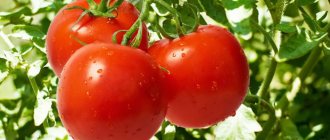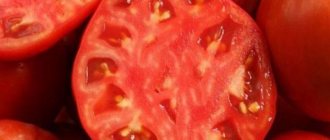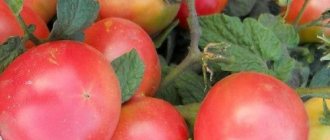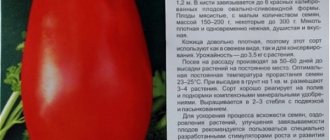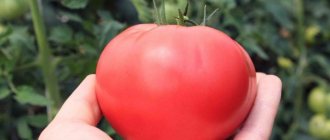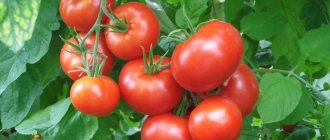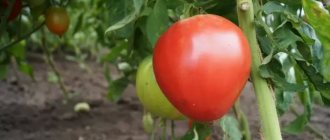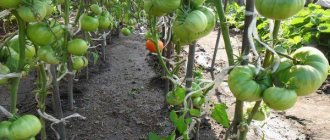Tomato Mystery of Nature variety description photos, reviews which is presented in this article, was created by Novosibirsk breeders and entered into the State Register of the Russian Federation in 2008. Climatic conditions in Siberia have their own characteristics: the weather is too capricious and unstable. In addition, in a short summer period there can be heat, cold, drought, and rain. In such conditions it is very difficult to grow a full crop of tomatoes.
The tomato variety Nature's Mystery was bred specifically for cultivation in regions with harsh climates and in areas of risky farming. It tolerates various weather changes well and is also resistant to many diseases. Tomatoes are recommended for growing in any climatic region.
Tomato “Mystery of Nature”: variety description
According to the degree of ripening, it belongs to the mid-early varieties. The ripening period of fruits takes about 108-110 days, which is an excellent result for large-fruited varieties, to which “The Mystery of Nature” belongs. A distinctive feature of this variety is its high yield - per 1 sq.m. you can get up to 16-17 kg .
The variety is designed for cultivation in greenhouses and under film covers. The height of the main stem can reach up to 1.9 m, which is typical for the indeterminate type. Such tomatoes grow as long as the growing season, or gardeners and farmers, allow them to do so. The advantage of such varieties is uniform and long-lasting yield.
In the table below you can see what the yield of other tomato varieties is:
| Variety name | Productivity |
| Mystery of nature | 16-17 kg per square meter |
| Grandma's gift | up to 6 kg per bush |
| Brown sugar | 6-7 kg per square meter |
| Premier | 6-9 kg per square meter |
| Polbig | 3.8-4 kg per bush |
| Black bunch | 6 kg per bush |
| Kostroma | 4.5-5 kg per bush |
| Red bunch | 10 kg per bush |
| Lazy | 15 kg per square meter |
| Doll | 8-9 kg per square meter |
You can learn more about the most common tomato diseases in greenhouses here. We will also tell you about ways to deal with them. On our website you will find reliable information about such scourges as Alternaria, Fusarium, Verticillium, late blight and methods of protection against late blight.
Soil preparation
To prevent the crop from getting sick, you need to take care in choosing a good place for planting.
Rotate plants every year. Otherwise, pests and spores that prefer tomatoes will accumulate in the soil. Follow the rules of crop rotation and do not plant tomatoes after crops such as:
- eggplant;
- potato;
- pepper;
- peas;
- garden Physalis;
And also in the old place and after other nightshades.
Friendly cultures
Description of friendly crops, after which the Miracle tomato variety grows well and produces high yields:
- cucumbers;
- zucchini;
- cabbage;
- turnips;
- green onions;
- carrots;
- pumpkins;
- squash;
- beets.
Having decided on the location, you can proceed to preparing the soil. The nature of tomatoes is such that they will taste the specific characteristics of the soil: looseness, lightness, air saturation and good moisture permeability. In the fall, it is dug up with the addition of manure, and if the soil is too heavy, you can also add sand. It is scattered evenly over the area and also dug in, mixed with soil.
Characteristics
- The shape of the fruit is flat-round.
- The fruits themselves are yellow, with a small pink cap at the base.
- But when cut, they are pinkish, looking like an exotic fruit. It is because of this unusual coloring that the variety got its name.
- The average weight of tomatoes is 350 g. Experts note that gardeners grow fruits weighing more than 700 grams.
You can compare the weight of the fruits of this variety with others in the table below:
| Variety name | Fetal weight |
| Mystery of nature | 350 grams |
| Bella Rosa | 180-220 |
| Gulliver | 200-800 |
| Pink Lady | 230-280 |
| Andromeda | 70-300 |
| Broody | 90-150 |
| Brawler | 100-180 |
| Grapefruit | 600 |
| De Barao | 70-90 |
| De Barao the Giant | 350 |
Like many pink-fruited tomatoes, the taste of “Mystery of Nature” is sweet and sugary, but at the same time the tomato has dietary properties due to the low content of purine acids, which is typical for varieties with a yellow color. In addition, beta-carotene contained in yellow-fruited vegetables is beneficial for the thyroid gland and for improving immunity.
“The Mystery of Nature” refers to the so-called salad varieties . In their raw form, these tomatoes best display all their flavor delights. In addition, this variety is perfectly used for sauces, juice, and pasta. Due to the fact that the fruits are large, it is impossible to preserve whole fruits. The variety is delicate, so you need to be careful during long-term transportation.
The main pros and cons of growing this variety.
The advantages include:
- High yield.
- Excellent tying.
- Resistance to temperature changes.
- Good taste and juiciness of the fruit, as well as original color.
- Unpretentious, can be grown in different climatic zones.
The disadvantages include:
- Massiveness of shoots.
- Requires high support due to height.
- The large size of the fruit requires a separate garter for each hand.
Photo
You can see the fruits of the “Mystery of Nature” tomato variety in the photo:
Planting seedlings
The recommended planting density for large bushes “Mysteries of Nature” is 3-4 bushes per square meter. Hence the layout of plants in a bed of 50x50 or 60x50 cm.
A teaspoon of complete fertilizer is added to the planting hole and mixed with soil. Immediately drive in (if this is not a greenhouse) a high support stake or trellis for future garter.
In greenhouses, natural fiber ropes are usually tied to the frame of the structure. Rooting of seedlings is also carried out by deepening the trunk. With their large sizes, this can be done with an inclination.
Features of cultivation
Sowing seeds for seedlings begins 50-60 days before planting in a permanent place. When planted in the ground for 1 sq.m. You need to place no more than 3 plants. Since the variety is tall, it requires support and garter. You can use trellises.
The first brush is formed over 8-9 sheets, the next one after another 3 sheets. Each hand is tied up due to its heavy weight. To obtain high yields, plants should be pinched and no more than 4-5 flowers should be left. “The Mystery of Nature” responds well to the use of mineral fertilizers and growth stimulants.
Bush care
To prevent tomatoes from getting sick, water them at the root; water should not get on the leaves.
Do this in the afternoon, so the moisture will not evaporate in large quantities. Avoid sprinkling, as it causes the temperature to drop sharply, which is not good for the plant.
Loosen the soil after watering, so it will not become crusty and will be able to breathe. At the same time, you can destroy weeds. The first loosening should be 8–12 centimeters deep for better aeration. But then, no deeper than 4–5 centimeters, so as not to damage the roots. Do not allow soil compaction, this will have a bad effect on the root system.
Form the bush in accordance with the variety required. This will increase its yield and make the plant effective. Collect fruits on time so that the juices are used to ripen new tomatoes.
Diseases and pests
Tomato diseases can destroy the entire crop, so disease control must begin before planting seedlings. Let's look at the most common of them for greenhouse tomatoes, which include “The Mystery of Nature.”
Late blight - at the beginning of the disease, the leaves turn brown, then the fruits turn brown. The disease is caused by large temperature changes and excessive humidity. Spraying with copper-containing preparations helps to cope with the disease in the early stages.
Tomato blossom end rot . It is characterized by depressed spots on green fruits. Excess nitrogen, lack of calcium or lack of moisture are the main causes. Regular watering and treatment with saltpeter solution helps to cope with the disease.
For leaf mold, the main symptom is the appearance of brownish-brown spots that are covered with a gray coating. The use of bacterial preparations and treatment of the plant with a solution of copper oxychloride will help cope with the disease.
Tomato mosaic is a very unpleasant disease. The distinctive features of the mosaic are colored spots that appear first on the leaves and then on the fruits. Prevention is done by washing the seeds in a 1% solution of potassium permanganate. Affected plants are burned.
Another disease is fruit cracking. But its cause is not mushrooms or viruses, but abundant watering during drought. When a large amount of water immediately enters the stem, and then into the fruit itself, its delicate skin cannot withstand the pressure and cracks. It is not difficult to cope with diseases; the most important thing is to notice them in time and diagnose them correctly.
In conclusion, I would like to wish you success in growing an excellent harvest of tomatoes, including the “Mystery of Nature” !
Useful video
You can get acquainted with tomato varieties suitable for greenhouses, including the “Mystery of Nature” variety in the following video:
In the table below you will find useful links about tomato varieties with different ripening periods:
| Mid-late | Mid-early | Super early |
| Volgogradsky 5 95 | Pink Bush F1 | Labrador |
| Krasnobay F1 | Flamingo | Leopold |
| Honey fireworks | Mystery of nature | Shchelkovsky early |
| De Barao Red | New Koenigsberg | President 2 |
| De Barao Orange | King of the Giants | Lyana pink |
| De Barao Black | Openwork | Locomotive |
| Miracle of the market | Chio chio san | Sanka |
If you find an error, please select a piece of text and press Ctrl+Enter.


